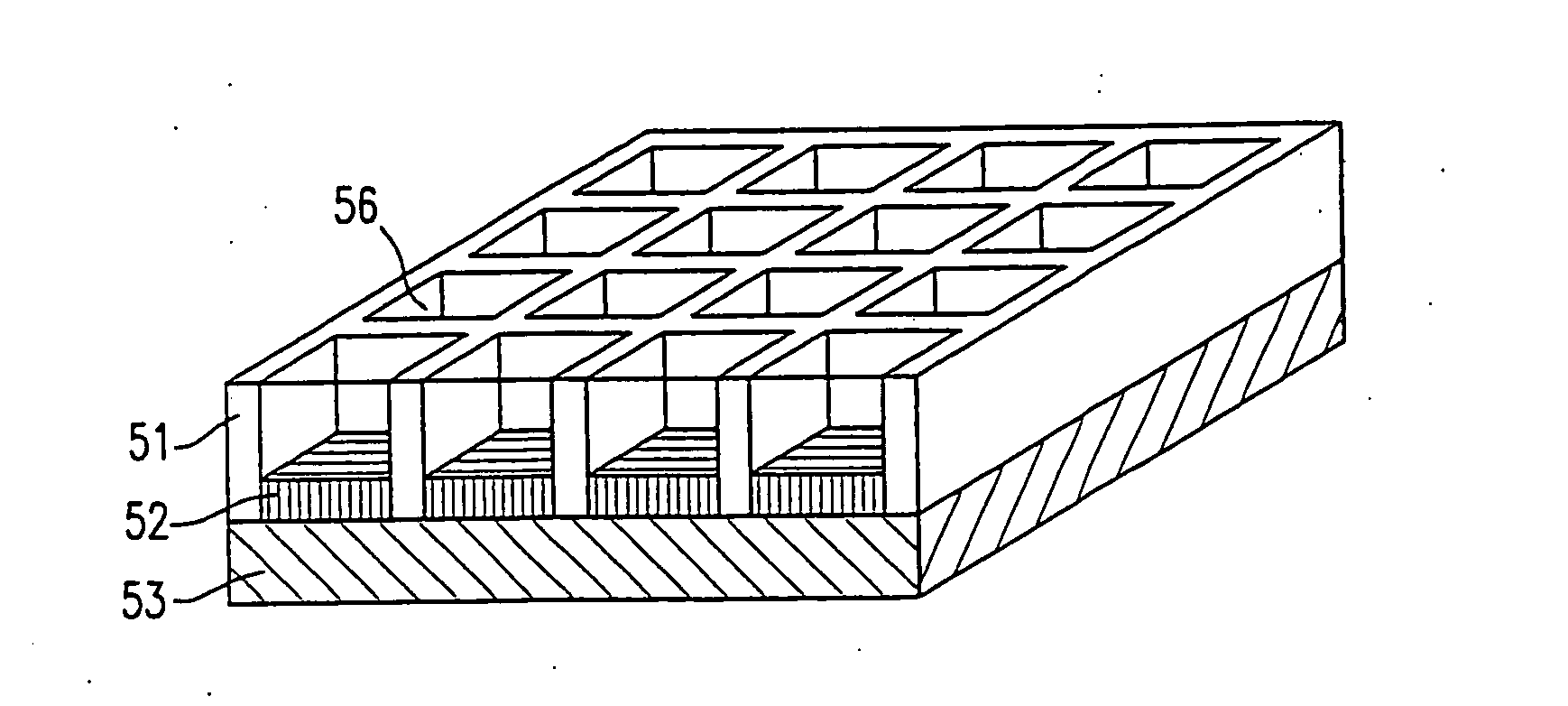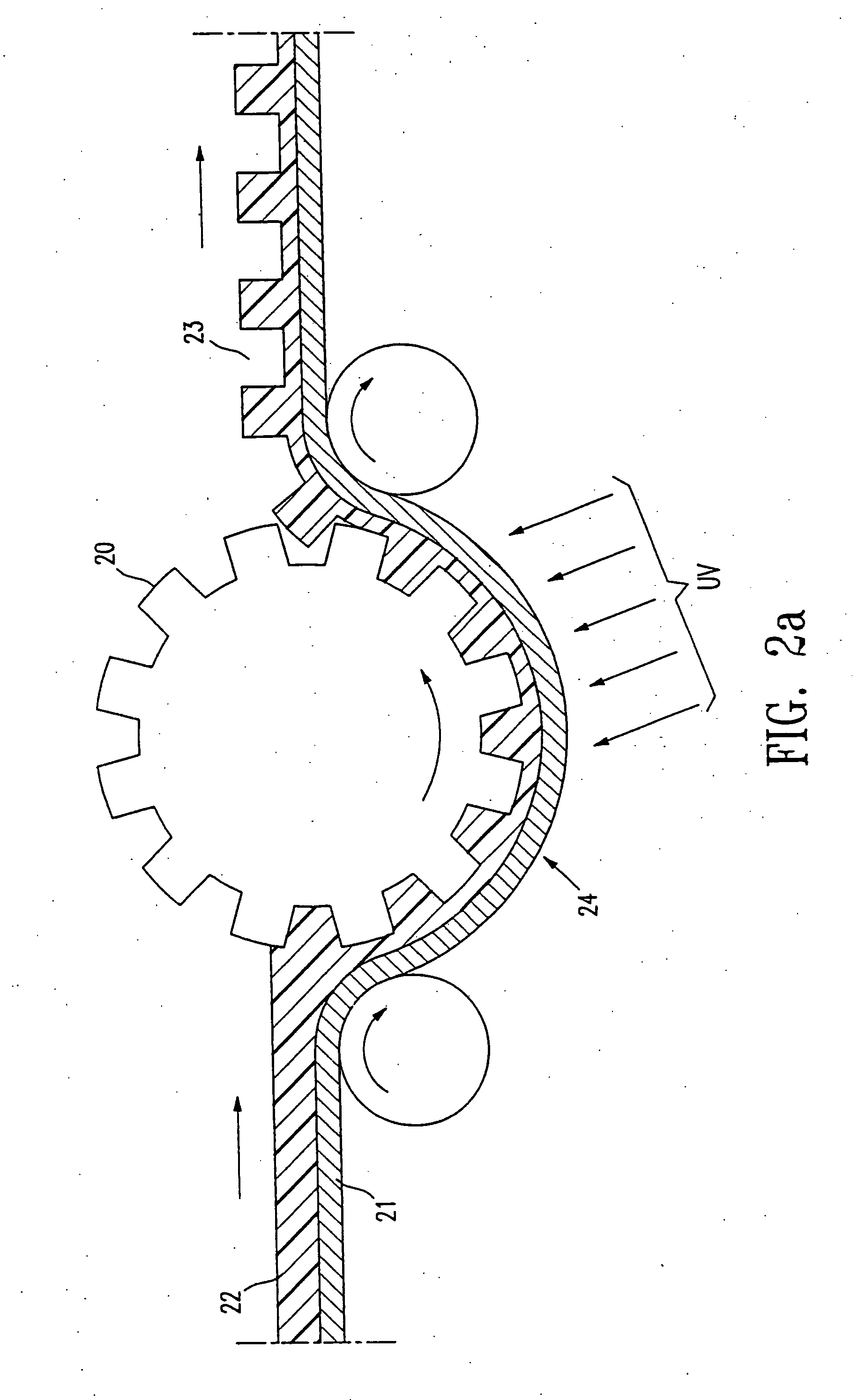Electrophoretic display
- Summary
- Abstract
- Description
- Claims
- Application Information
AI Technical Summary
Benefits of technology
Problems solved by technology
Method used
Image
Examples
example 1
Preparation of Microcups by Microembossing
[0111] The composition shown in Table 1 is coated onto Mylar J101 / 200 gauge using a Nickel Chrome bird type film applicator with an opening of 3 mil. The solvent is allowed to evaporate leaving behind a tacky film with a Tg below room temperature.
TABLE 1PMMA-containing Composition for MicroembossingNo.DescriptionIngredientSupplierWt %1Epoxy acrylateEbecryl 3605UCB7.35Chemicals2MonomerSartomer SR205Sartomer9.593Urethane acrylateEbecryl 6700UCB4.87Chemicals4Poly-Elvacite 2051ICI9.11methylmethacrylate5PhotoinitiatorDarocur 1173Ciba1.456CationicCyracureUnion Carbide0.60photoinitiatorUVI 69767SolventAcetoneAldrich67.03Total100.00
[0112] A pre-patterned stencil from Photo Stencil, Colorado Springs, Colo., was used as the male mold for microembossing and Frekote 700-NC from Henkel was used as the mold release. The coated film was then embossed by the stencil using a pressure roller at room temperature. The coating was then UV cured for about 20 m...
example 2
[0113] A composition containing solid oligomer, monomer and additive is shown in Table 2. The glass transition temperature of the mixture is again below room temperature. The tacky coating is deposited on top of Mylar J101 / 200 gauge as before. Embossing can be conducted at 32° C. and 60° C. using a heated pressure roller or laminator. Well-defined high resolution microcups (100-400 dpi) with depth ranging from 5-30 microns were produced.
TABLE 2Embossing CompositionNo.DescriptionIngredientSupplierWt %1Epoxy acrylateEbecryl 3903UCB Chemicals17.212MonomerHDODAUCB Chemicals8.613Urethane acrylateEbecryl 4827UCB Chemicals2.874PhotoinitiatorIrgacure 500Ciba1.435SlipEbecryl 1360UCB Chemicals1.606SolventAcetoneAldrich68.26Total100
example 3
[0114] A primer solution comprising of 5 parts of Ebecryl 830, 2.6 parts of SR-399 (from Sartomer), 1.8 parts of Ebecry 1701, 1 part of PMMA (Mw=350,000 from Aldrich), 0.5 parts of Irgacure 500 and 40 parts of methyl ethyl ketone (MEK) was coated onto a 2 mil 60 ohm / sq. ITO / PET film (from Sheldahl Inc., MN.) using a #3 Myrad bar, dried, and UV cured by using the Zeta 7410 (5 w / cm2, from Loctite) exposure unit for 15 minutes in air.
[0115] 35 Parts by weight of Ebecryl 600 (UCB), 40 parts of SR-399 (Sartomer), 10 parts of Ebecryl 4827 (UCB), 7 parts of Ebecryl 1360 (UCB), 8 parts of HDDA (UCB), 0.05 parts of Irgacure 369 (Ciba Specialty Chemicals) and 0.01 parts of isopropyl thioxanthone (ITX from Aldrich) were mixed homogeneously, coated onto the primer treated ITO / PET film with a targeted thickness of about 50 μm, and embossed with a Ni—Co male mold having a 60 (length)×60 (width) μm repetitive protrusion square pattern with 25-50 μm protrusion height and 10 μm wide partition lines...
PUM
 Login to View More
Login to View More Abstract
Description
Claims
Application Information
 Login to View More
Login to View More - R&D
- Intellectual Property
- Life Sciences
- Materials
- Tech Scout
- Unparalleled Data Quality
- Higher Quality Content
- 60% Fewer Hallucinations
Browse by: Latest US Patents, China's latest patents, Technical Efficacy Thesaurus, Application Domain, Technology Topic, Popular Technical Reports.
© 2025 PatSnap. All rights reserved.Legal|Privacy policy|Modern Slavery Act Transparency Statement|Sitemap|About US| Contact US: help@patsnap.com



